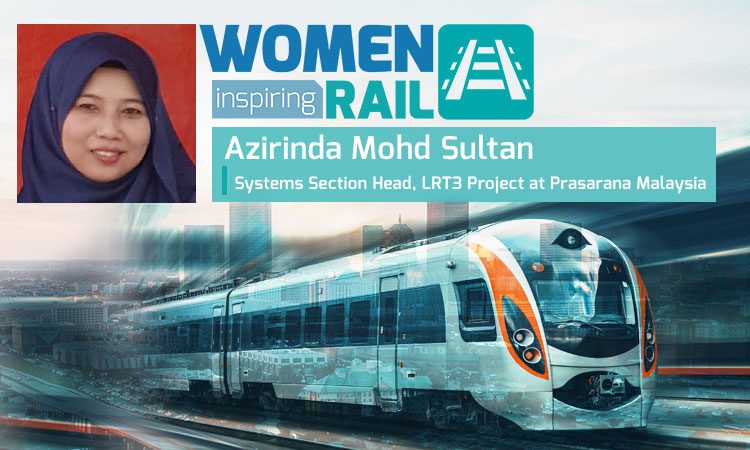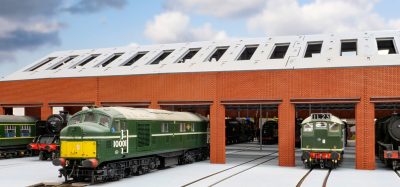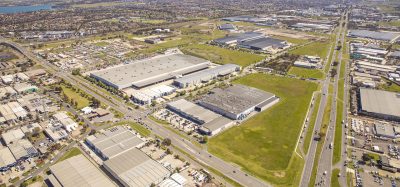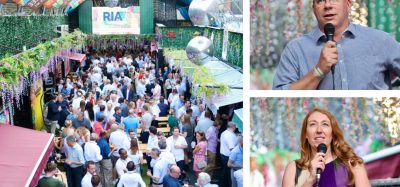Women Inspiring Rail: Q&A with Azirinda Mohd Sultan, Systems Section Head at Prasarana Malaysia
Posted: 7 October 2019 | Azirinda Mohd Sultan | No comments yet
For our next Women Inspiring Rail instalment, Azirinda Mohd Sultan, Systems Section Head at Prasarana Malaysia explains how breaking traditional ’employer thinking’ has meant that she has been able to inspire more women into joining rail-related engineering roles.


How did your career in rail begin and what does your current job involve?
My career in rail started 10 years ago when our team was required to switch tasks from power plant to transportation design due to a high power plant reserve margin in Malaysia, which resulted in no new power plant development within our country. I started as a M&E Project Manager for Mudajaya Corporation, carrying out detailed design engineering services of the Kuala Lumpur International Airport (KLIA) Spur-line Project. My involvement in the transportation field became larger and more significant when I was involved in the following projects:
- Electrical Project Manager responsible for Detailed Design Engineering for Kelana Jaya (KLJ) LRT Extension Project for Prasarana. Also, responsible as Lead local support team for the E&M System which is being jointly undertaken by Minconsult and Mott MacDonald
- M&E Project Manager responsible for Detailed Design Engineering for Terminal Gombak Project and Subang Depot Workshop Extension and New Administration Building Project for Prasarana
- M&E Project Manager responsible as Technical Consultant for KLIA2 Proposed Privatisation Packages for Malaysia Holdings Berhad (MAHB)
- Project Manager responsible as System Study Consultant for Kretapi Tanah Melayu Berhad (KTMB) Fleet Expansion (Power System Study) for the Ministry of Transport (MOT), Malaysia.
In 2005, I began to think about my future and career development. I started comparing the pros and cons of staying in the power plant and transportation industries. My assessment showed that the transportation industry was rapidly developing especially around Klang Valley, and that promised better career achievements for me. Besides, I like to be challenged and wanted to explore something different. I realised that I enjoyed supporting Mott MacDonald in E&M System and conduct power simulation study for KTMB Fleet Expansion. Therefore, I joined Mott and became their International System Consultant. I became a key member for the Klang Valley Mass Rapid Transit (KVMRT1) Project for Sungai Buloh- Kajang (SBK) Line, Klang Valley Double Track (KVDT) Rail Network Infrastructure Assessment & Procurement Support for the Ministry of Transport, Malaysia and EMU Depot, Seremban for KTMB.
I joined Prasarana in 2014, the biggest government-owned company handling and operating public transportation in Malaysia. My ambition was to change the conventional way of ‘employer thinking’ to an open approach that was driven by system requirement. Besides, it is essential to understand the operation needs and utilise new proven technology to develop the Malaysian railway industry
After 10 years as a consultant, I felt that I only have the freedom to adopt new technologies into requirements and specifications if I am the employer or client of a project. I joined Prasarana in 2014, the biggest government-owned company handling and operating public transportation in Malaysia. My ambition was to change the conventional way of ‘employer thinking’ to an open approach that was driven by system requirement. Besides, it is essential to understand the operation needs and utilise new proven technology to develop the Malaysian railway industry. A lack of technical women in the railway industry, especially in Prasarana, motivated me to inspire more women to enter into the engineering field. I started my job in the Wayside Team, handling upgrading projects for the existing Kelana Jaya Line, Ampang Line and Monorail Line. My dream to improve specifications for the Malaysian Railway Project came true when I was selected to join the new Light Rail Transit Line 3 (LRT3) Project team in 2015. I am now leading the LRT3 System on four main system packages namely; signalling, telecommunications, power supply and distribution and automatic fare collection (AFC) system. I deal with technical and contractual matters, which includes:
- Assisting System Head by reporting and managing red tape or issues with regards to the technical, contractual and commercial matters
- Leading meetings with local councils, authorities, utilities and service providers on technical and commercial matters (tariff, sales agreement, etc.)
- Assisting ICE and SPAD on the technical input for final design approval for items related to safety and compliance
- Participating in workshops during concept design, particular specification development, preliminary design, final design, etc. Review managers’ comments – validate and recommend to System Head on acceptance of Preliminary Design Report and Final Design Report, highlighting any risks, concerns and/or interfacing gaps.
What aspects of your job do you find the most challenging/rewarding, and why?
I believe that communication skills and flexibility in receiving and accepting ideas are two main assets that have led me to become as confident as I am now.
Being a female boss in an engineering field is one of the challenges that I face, especially in the male-dominated professions that the power plant and railway industries are. At first, I found it difficult to gain trust and respect from my male subordinates. It required greater effort from me to convince and make them comfortable in accepting me as their superior. I believe that communication skills and flexibility in receiving and accepting ideas are two main assets that have led me to become as confident as I am now. I am blessed to have trust and full support from my team and management.
Having the versatility to swap between consultant to client is a big challenge for me. I thought that my vast technical knowledge was good enough to handle a project, but I was wrong. As a client, I needed to balance between technical requirements and cost impact in all my approaches and decisions. My first challenge in being an employer is to develop an Employer’s Requirement (ER) for LRT3 Project Delivery Partner Tender Document. Since Prasarana is the project owner and the LRT3 operator, each requirement to be included inside the ER must always comply with operation needs, safety compliance and performance. Those requirements need to balance the Project Cost (CAPEX) and Operation Cost (OPEX). Rounds of workshops and discussions were carried out with the stakeholders, including the operator, manufacturers, consultants and authorities, to ensure the ER comply with the standards and at the same time develop improved specifications.
The first milestone was achieved when we completed the LRT3 ER. The ER was then verified and validated by the international consultant and tendered out. What was exciting for me at that time was the fact that my team and I had successfully brought the project specifications’ level up one step by including new technologies and new operating regimes for the project. Besides, as a Green Building Facilitator, green sustainability and technology requirements have been incorporated inside the ER. It was considered to be the first railway station in Malaysia to have Green Building Index (GBI) Silver Rating Certification, and with therapeutic landscape features. LRT3 shall be based on proven high efficiency and green technology with an energy consumption reduction strategy. We successfully made the progression from conventional to open approach operation thinking.
What is it about the rail industry that you are most passionate about?
Coming from a system background, I am passionate about the evolution of railway system technology. I want the Malaysian railway to be in-line with the fast-moving world.
Coming from a system background, I am passionate about the evolution of railway system technology. I want the Malaysian railway to be in-line with the fast-moving world. In the Asian railway industry, Malaysia has a lot of things to catch up with compared to Singapore, Hong Kong or Taiwan. However, it’s better late than never. My team has never given up pushing for design optimisation through value engineering and industrial collaboration programmes. This is also a challenge since at each step, we need to ensure the requirements do not create any variation.
What has been your biggest achievement/proudest moment so far in your rail career?
Being one of the local pioneers capable of carrying out simulation of power traction study and output assessment is the biggest achievement in my career. This has contributed to my current career development and achievement. In September 2015, I conducted research and published a paper on “Simulation Assessment of the Existing KTMB Klang Valley 25kV Traction Power System Adequacy to Support the New 6-Car Train with Shorter Headway Commuter Service Operation”.
I have led my LRT3 system team to participate in an Innovative and Creative Circle (ICC) Convention. We gained knowledge on the technology’s evolution and new operation regime by adopting energy saving technology as implemented in green building construction to improve energy sustainability and minimise energy wastage inside our train. We received the following recognition:
- Second runner-up for Prasarana’s Innovative & Creative Circle (ICC) Convention
- Gold award for Regional Team Excellence 2019 (Northern) by Malaysia Productivity Corporation (MPC)
- Qualified for National Team Excellence 2019 – Annual Productivity & Innovation Convention (APIC) 2019.
How has the rail industry evolved since you joined?
Yes, very much so. The train used to be operated by a driver – now it is computerised. The signalling system moved from fixed block to CBTC System, the communication system from analogue, tetra and now on-board Wi-Fi, the power system from having direct burning access power (AARU) to green approach having energy recovery system (ERS) which recycles the access power generated by the train for station use, etc.
What have been the biggest changes?
The biggest changes so far and in the foreseeable future are awareness in green technology, reduction in energy consumption demand, concern around railway equipment and system sustainability, and finally, evolution of the communication system both ways as well as on-board. The communication system, which is the backbone of the railway system, will now move to a more secure and reliable technology such as LTE. Unfortunately, LTE in Malaysia is only for TELCO and the bandwidth allocation act is yet to be developed for railway application.
Who within the rail community has been an inspiration to you, and why?
Out of all the railway stakeholders, for me, the commuter is the one who has inspired me the most. It is an honour for me to be involved in a railway infrastructure project that has, and will, benefit the public by providing them with good accessibility and increasing local connectivity. As part of the Prasarana family, we want to ensure the public receives the best possible service from the moment they enter the station. Their satisfaction and comfort will be a meaningful recognition to the designers, engineers, asset owner and also operator of the railway line.
What can be done to diversify the workforce in the rail sector?
In my opinion, currently, the workforce in the rail sector is already diverse. However, there is always room for improvement.
In my opinion, currently, the workforce in the rail sector is already diverse. However, there is always room for improvement. Sharing information, experience and exposure to the latest technology within railway stakeholders either within the country or globally is one of the ways to start. Gaps can be identified, and new opportunities can be created. Fresh ideas and different views from students and young engineers should be welcomed and considered.
What advice would you give to those thinking about pursuing a career in rail?
Malaysia’s railway system is expanding and there will be a lot of opportunities to explore in the near future. Green technology, maintainability, sustainability, reliability, cost optimisation and compliance with operational safety are the challenges to be faced in the industry in the coming years. Let’s get involved in one of the most challenging and dynamic industry in the world and diminish the gender gap between women and men in the rail industry. Together we can develop and bring the railway industry to a higher and better level.
If you would like to take part in the Women Inspiring Rail series, or would like to nominate a colleague to part, please email: Craig Waters, Editor, Global Railway Review.







